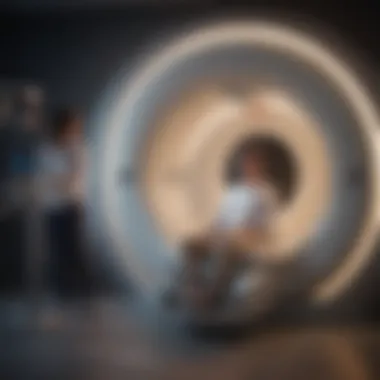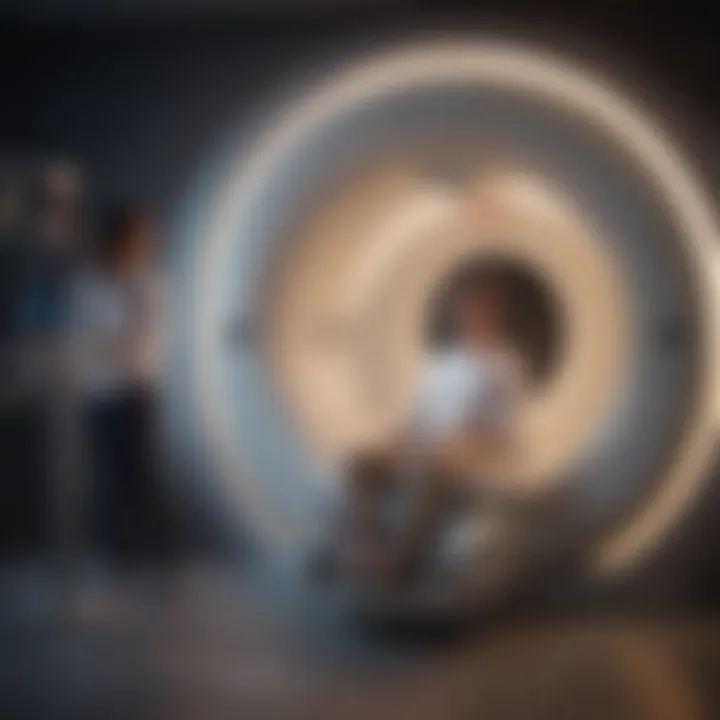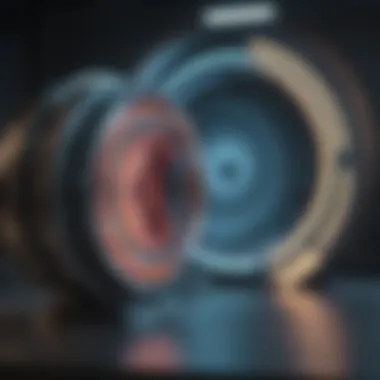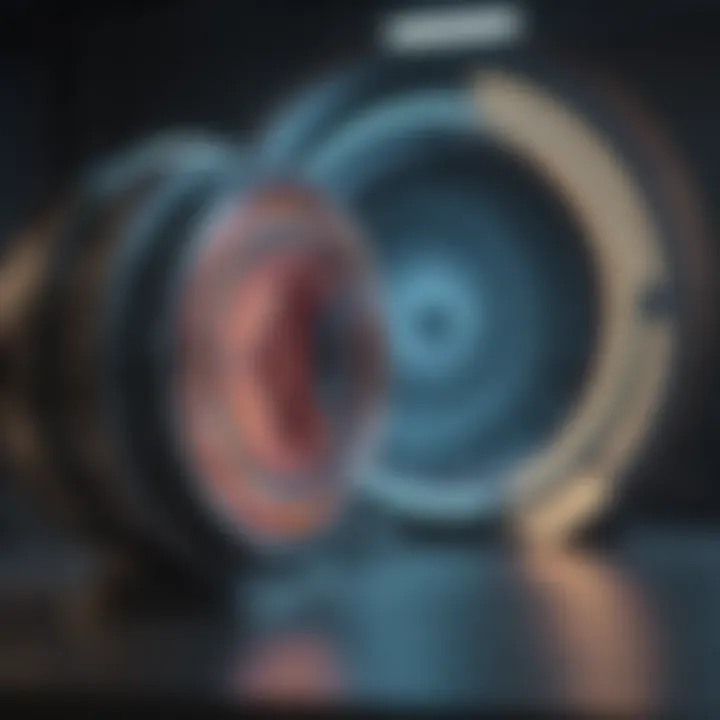Understanding Open MRI Technology: A Comprehensive Overview


Intro
Open MRI technology represents a significant leap in medical imaging. It offers a less restrictive alternative to traditional MRI systems, which can be overwhelming for many patients. Open MRI machines are designed to enhance comfort while still providing high-quality images for diagnostics. This introductory section sets the stage for understanding how these systems function, their applications, and their implications for patient care.
As the demand for healthcare solutions evolves, open MRI has carved its niche in the medical landscape. Practitioners and patients alike are interested in its unique selling propositions, such as a wide-open structure and reduced anxiety during scans. These aspects contribute to improving the overall experience and outcomes of imaging procedures.
In this article, we will dive deeply into various facets of open MRI technology. From its distinct operational principles to a critical analysis of its clinical applications, we aim to provide a clear understanding of its relevance in modern healthcare.
Research Overview
Summary of Key Findings
Research highlights several advancements and benefits linked to open MRI technology. Some notable findings include:
- Enhanced Patient Comfort: Open MRI systems allow for more natural positioning, reducing the feelings of claustrophobia that some patients experience with traditional machines.
- Broader Patient Demographics: These systems can accommodate larger patients and more diverse populations, particularily children and those with disabilities.
- Innovative Imaging Techniques: Some open MRI technologies now produce high-resolution images comparable to their closed counterparts.
The introduction of open MRI is transforming imaging practices. Its implementation is promising, with many facilities adopting the technology to cater better to patient needs.
Relevance to Current Scientific Discussions
Open MRI technology raises important questions about patient care, diagnostic efficacy, and healthcare policy. It challenges traditional paradigms of imaging, prompting discussions on how to provide the best possible outcomes in a patient-centric manner. Researchers and practitioners are particularly focused on the balance between technological capabilities and the human experience during medical procedures. This makes open MRI a focal point for ongoing debates in medical imaging and patient safety.
Methodology
Research Design and Approach
The framework for understanding open MRI technology comprises both qualitative and quantitative research methods. Surveys and interviews with healthcare providers using open MRI systems provide valuable insights. Furthermore, examining patient feedback on their imaging experiences helps identify strengths and weaknesses of these machines.
Data Collection and Analysis Techniques
Data is collected through various means, including:
- Surveys: Gathering responses from patients regarding their experiences and comfort levels.
- Clinical Assessments: Comparing the image quality and diagnostic accuracy between open MRI and traditional systems.
- Literature Review: Analyzing peer-reviewed articles and case studies related to advancements in open MRI technology.
By synthesizing information from multiple sources, a comprehensive understanding emerges, guiding both practitioners and patients in making informed choices about their imaging options.
Foreword to MRI Technology
Magnetic resonance imaging (MRI) represents a significant leap forward in medical imaging technology. This section aims to illuminate not only the scientific principles behind MRI but also its historical development, shaping our understanding of how these machines work.
The timeline of MRI is crucial for grasping its importance in modern healthcare. Understanding the key milestones in this field allows practitioners and researchers to critically assess the evolution of imaging techniques and their relevance to current medical practices. Contributions from physicists and engineers have all played a role in enhancing the capabilities and applications of MRI, thus making it a necessary tool in diagnostics.
Moreover, fundamental principles of MRI are key factors that lend to its unique imaging capabilities. Understanding these principles not only aids in determining the reliability of MRI results but also informs the choice between different imaging modalities in clinical practice.
Understanding MRI technology is the first step to appreciating the open MRI systems. Having a solid grounding in MRI technology can facilitate more informed discussions about the potential benefits and limitations of open MRI systems. This knowledge empowers both medical professionals and patients, ensuring they can make better choices in diagnostics and treatment options.
Defining Open MRI


Open MRI is a term that refers to a specific type of magnetic resonance imaging system, distinguished mainly by its design and operational methodology. Understanding this definition is crucial for recognizing the technology's place within the broader spectrum of medical imaging. The importance of defining Open MRI lies in its clinical applications, patient accessibility, and the unique challenges it addresses compared to traditional closed MRI systems.
What Constitutes Open MRI?
Open MRI machines feature a wide or open design that allows for more room around the patient's body during the scanning process. Unlike traditional MRI machines, which have a narrow tunnel that patients must enter, open MRI systems create a less confining environment. This openness can be beneficial for patients with claustrophobia or those who experience anxiety during scans. Open MRIs can have different configurations, but they typically employ two magnets situated on either side of the patient. This design contrasts sharply with older models, which can be intimidating and uncomfortable for some individuals.
A few notable characteristics of Open MRI machines include:
- Larger Opening: The broader opening makes it easier for patients to enter and exit.
- Increased Visibility: The lack of a full enclosure allows patients to see their surroundings, which can ease anxiety.
- Versatile Scanning Options: Certain open MRIs allow for various positioning solutions, accommodating patients who may have difficulty lying flat.
Ultimately, Open MRI systems strive to offer an alternative solution for imaging without compromising diagnostic effectiveness, making them a relevant topic in modern radiology practices.
Difference Between Open and Closed MRI
The distinction between Open and Closed MRI systems is significant and is rooted in several core differences. Understanding these disparities can help inform decisions made by healthcare professionals regarding which imaging method to use based on specific patient needs.
First, we can consider the magnetic field strength. Closed MRIs generally use stronger magnetics, around 1.5 Tesla (T) to 3.0 T, resulting in high-resolution images. In comparison, Open MRIs usually operate at lower field strengths, often around 0.2 T to 1.0 T, which can lead to less detailed images but provides a more comfortable experience for patients.
Next, the positioning and accessibility play a vital role. In Closed MRIs, patients may feel confined, which contributes to heightened stress levels. Open MRIs allow for greater positioning flexibility. This flexibility aids in accommodating patients who have mobility challenges or who may need specialized positioning for particular diagnostic needs.
Additionally, the applications of Open versus Closed MRI vary. Closed MRIs are generally preferred for more extensive diagnostic projects where detailed image clarity is crucial. Meanwhile, Open MRIs may be more suitable for specific examinations, such as orthopedic evaluations or scans for patients who cannot tolerate being enclosed in a traditional machine.
In summary, Open MRI systems represent an alternative approach to medical imaging, prioritizing patient comfort while still delivering vital diagnostic capabilities. As practitioners and patients navigate their options, understanding the nuances between Open and Closed MRIs is essential for making informed choices.
Technical Aspects of Open MRI Machines
Understanding the technical aspects of open MRI machines forms a critical part of comprehending their functionality and relevance in healthcare. The design, magnetic field strength, and image quality considerations are crucial elements that differentiate open MRI from traditional closed MRI systems. By examining these components, we can appreciate the unique advantages and limitations of open MRI technology.
Design and Structure
The design and structure of open MRI machines are significantly different from conventional MRI units. Open MRIs often feature a wider opening that allows for easier patient access, enhancing comfort during the scanning process. This design reduces the feeling of confinement often associated with closed systems. Moreover, many open MRI models are less bulky, making them easier to install in various medical facilities. The open architecture is particularly beneficial for patients who experience anxiety or claustrophobia.
These machines typically consist of two large magnets positioned parallel to each other, creating a cylindrical gap for the patient. This design allows for more flexibility in patient positioning, especially for larger patients or those with specific medical needs. The open nature also facilitates faster patient transfers, which can improve workflow in busy hospital environments. Understanding these structural elements is essential when considering the practical implications of open MRI technology in clinical settings.
Magnetic Field Strengths
Magnetic field strength, measured in Tesla, is crucial in determining the capabilities of an MRI machine. Open MRI systems usually operate at lower magnetic field strengths, often around 0.35 to 1.2 Tesla. This is in contrast to traditional closed MRI systems, which can reach strengths of 3 Tesla or more. The reduced field strength in open MRIs means they can sometimes provide lower resolution images compared to higher-strength systems.
However, it is important to note that advances are being made in open MRI technology. Manufacturers are working to enhance the magnetic field strength without compromising patient comfort. An adequate magnetic field strength is vital for the detection and characterization of various medical conditions. Thus, while open MRI may have limitations in imaging resolution, its growing technological advancements aim to bridge this gap.
Image Quality Considerations
The quality of images produced by open MRI systems is a fundamental consideration in this technology's evaluation. In general, image quality in MRI is influenced by several factors, including magnetic field strength, signal-to-noise ratio, and acquisition techniques.
In open MRI, lower magnetic field strength often results in a trade-off, where some subtle details in the images may not be as clear compared to those produced by closed MRI machines. Despite these limitations, open MRIs can still yield acceptable images for many clinical applications, such as orthopedic and pediatric imaging.
Moreover, image processing techniques and post-acquisition analysis can enhance the quality of images obtained from open MRI scans. It is essential for healthcare professionals to weigh the benefits of patient comfort against the potential minor compromises in image details. Ultimately, the decision to use open MRI technology should take into account the specific clinical context and requirements.
Open MRI systems promise a unique blend of patient-centric design and evolving technology that addresses the needs of diverse patient populations, all while engaging in continuous improvements in image quality and resolution.


Clinical Applications of Open MRI
Open MRI technology has made significant strides in healthcare, especially in terms of clinical applications. Its design allows for a broader range of imaging, making it suitable for various specialties. Understanding these applications is vital for practitioners who seek to leverage the advantages Open MRI offers.
Orthopedic Imaging
Orthopedic imaging is one of the primary uses of Open MRI. This technology provides detailed views of bones, joints, and soft tissues. It is particularly beneficial for diagnosing conditions such as torn ligaments, cartilage damage, and fractures. The non-restricted environment of an Open MRI machine encourages patients to relax. This is crucial as tension can lead to movement artifacts in the images. Moreover, the larger opening accommodates patients with mobility issues easily, which is especially important in an orthopedic context where joint pain or injury may limit mobility.
Neurological Assessments
For neurological assessments, Open MRI presents unique benefits. Unlike traditional closed MRIs, which might induce anxiety in patients, Open MRI systems help alleviate claustrophobic feelings. This is beneficial when imaging the brain or spinal cord, where patient movement must be minimized for accurate results. Conditions such as multiple sclerosis or brain tumors often require detailed imaging for an accurate diagnosis. The flexible positioning options in Open MRI allow clinicians to obtain the best views of the area of interest without compromising patient comfort. As a result, this technology is becoming an increasingly important tool in the neurological field.
Pediatric Uses
The use of Open MRI in pediatrics highlights its adaptability for younger patients. Children may experience more fear or discomfort in traditional MRI settings, which can lead to inadequate imaging. Open MRI machines offer a more welcoming atmosphere. Features like larger openings and boarder imaging space are less intimidating. This is especially important in pediatrics as accurate imaging is crucial for detecting developmental disorders, congenital anomalies, and other conditions. A child’s comfort can significantly affect the quality of the imaging, making Open MRI an essential resource in pediatric care. The likelihood of successful imaging outcomes increases when children feel safe and at ease.
In summary, Open MRI has a broad range of clinical applications that enhance diagnostic capabilities across various specialties.
Its impacts run deep in orthopedic, neurological, and pediatric contexts, reflecting its role in modern healthcare.
Advantages of Open MRI Systems
Open MRI systems offer several significant advantages that enhance patient care and clinical practice. This section examines the specific benefits of open MRI, focusing on how these features contribute to improved patient comfort and accessibility, reduced anxiety, and enhanced options for positioning during scans.
Patient Comfort and Accessibility
Open MRI systems are designed with patient experience in mind. Unlike traditional closed MRI machines, open MRI machines feature a wider and more open design. This design quality significantly increases patient comfort. Patients often feel less restrained and can enter the machine without the fear commonly associated with being enclosed in tight spaces.
Accessibility also plays a crucial role in patient comfort. Open MRIs accommodate a diverse range of patients, including those who are larger or have mobility concerns. Larger openings allow for easier entry and exit, reducing the physical effort required by patients. Additionally, the capability of accommodating different body types is essential for inclusive healthcare practices.
Reduced Claustrophobia and Anxiety
One of the primary benefits of an open MRI is its ability to cater to patients who experience claustrophobia or anxiety during imaging procedures. Research indicates that a significant number of individuals feel uncomfortable in the enclosed environment of traditional MRIs. The open design of open MRIs can alleviate these feelings by providing a more spacious view and interaction with the surrounding environment.
Patients often report feelings of calmness and security when using open MRIs. This important consideration can lead to better cooperation during imaging sessions, which helps ensure high-quality results. Furthermore, reduced anxiety can enhance the overall imaging experience, allowing healthcare providers to conduct scans more efficiently.
Enhanced Positioning Flexibility
Another noteworthy advantage of open MRI systems is the enhanced positioning flexibility they provide. Health professionals can place patients in various positions to achieve the optimal scan for specific areas of interest. This flexibility proves particularly beneficial for imaging larger body parts, such as hips and legs, where positioning options are critical for obtaining accurate images.
Also, this flexibility can reduce the need for repositioning patients frequently during a single imaging session. Fewer adjustments minimize discomfort and contribute to a more efficient workflow within healthcare facilities. The ability to easily accommodate diverse positioning requirements makes open MRI a valuable tool in various clinical settings.
"Open MRI technology is not just about comfort; it actively enhances the quality of diagnostic imaging by catering to the needs of patients."
Limitations of Open MRI Systems
Though open MRI technology introduces advantages, it is crucial to understand its limitations. Knowing these constraints allows healthcare providers to make informed decisions about patient imaging needs. Open MRI systems have limitations that can affect image quality, accessibility, and cost.
Challenges in Image Resolution


One significant concern with open MRI systems is the challenge of image resolution. The technical design of open MRIs often results in lower resolution imaging compared to traditional closed MRI systems. The decreased magnetic field strength in open MRIs can lead to images that are less detailed, which can be critical in diagnosing certain conditions.
"Lower image resolution can impact diagnostic accuracy, particularly for subtle abnormalities."
Medical practitioners must weigh the benefits of patient comfort against the potential for reduced image clarity. Open MRI machines generally operate at strengths of 0.2 to 1.0 Tesla. In contrast, conventional systems often operate at 1.5 Tesla and above. This discrepancy is one reason why open MRI might not be appropriate for all examinations, especially those requiring detailed imaging, like neuroimaging or oncological assessments.
Magnetic Field Variability
Another notable limitation arises from magnetic field variability. The non-uniform distribution of the magnetic field in open systems can lead to inconsistent image quality. This variability can cause artifacts in the scans, which may hinder accurate interpretation. It also poses challenges in achieving the same level of diagnostic confidence as with closed MRI systems.
Clinicians should be aware of this variability when choosing imaging modalities for their patients. Depending on the specific case, they might recommend a traditional MRI over an open one to ensure higher fidelity in imaging results.
Cost Considerations
Cost is yet another aspect where open MRI systems may fall short. Although open MRIs are designed to offer a more comfortable experience, the initial investment for these systems can be substantial. Their lower resolution and longer scan times can lead to increased costs over time, due to the need for repeat scans or additional imaging studies.
Facilities may also face higher operational costs due to the potential for reduced throughput compared to traditional MRI systems. Patients might not only experience longer waiting times, but also higher financial burdens from multiple imaging sessions to obtain the necessary diagnostic information.
In summary, while open MRIs provide distinct advantages, particularly regarding patient comfort, they also come with limitations that need careful consideration. Understanding these aspects allows for better patient care and decision-making in the imaging process.
Future Directions in MRI Technology
The evolution of MRI technology continues to gain interest from both the medical community and the general public. Future directions in MRI technology promise to enhance both the efficiency and effectiveness of imaging techniques. Innovations aim to elevate clinical outcomes by improving diagnostic accuracy and patient comfort. Understanding these advancements helps practitioners and patients grasp how the landscape of medical imaging is changing.
Innovations in Open MRI Designs
Open MRI machines have undergone significant improvements since their inception. Newer models incorporate larger openings and advanced magnetic field configurations that enhance the efficacy of imaging. For instance, the introduction of high-field open MRI systems helps bridge the gap between traditional closed MRI and open systems. This shift allows for clearer, more precise images without compromising on patient accessibility.
Recent developments have also focused on portability. Emerging designs consider mobile MRI units that can be utilized in various settings, including rural areas. This accessibility can elevate the standard of care for underserved communities.
Moreover, technological integrations, such as artificial intelligence, are becoming increasingly prevalent in the field of MRI design. These integrations can assist in automating certain procedures, thereby reducing the required time per scan. Additionally, tools like standardized object placement aids enhance consistency and reduce operator-induced variability in imaging. This leads to improved patient outcomes in diagnoses.
Integration with Advanced Imaging Techniques
The integration of open MRI technology with advanced imaging methods marks a significant progress in diagnostic accuracy. Techniques such as functional MRI (fMRI) and diffusion tensor imaging (DTI) are being combined with open systems. This combination provides deeper insights into brain activity and connectivity. As a result, clinicians gain sharper visibility into neurological conditions, enhancing treatment plans.
Incorporating molecular imaging methods with open MRI could prove beneficial as well. Techniques like positron emission tomography (PET) when integrated with MRI give a comprehensive view of biological processes. This hybrid approach can assist in onco-diagnosis by providing both functional and structural data, crucial for understanding tumor behavior.
Furthermore, cloud-based technologies enable the storage and sharing of MRI data. This facilitates collaborative diagnostics and treatments among healthcare professionals globally. Fast communication between specialists can lead to faster, more accurate patient assessments, yielding timely interventions.
"The integration of multiple imaging techniques is crucial for advancing patient care and the field of radiology."
End
The conclusion serves a vital role in reinforcing the relevance and significance of open MRI technology. This section emphasizes how open MRI systems enhance patient care through improved accessibility and comfort. The ability to accommodate patients who experience claustrophobia or those requiring varying positions during scans is a prominent advantage. These factors lead to increased compliance and better diagnostic outcomes.
Summarizing Open MRI's Impact on Patient Care
Open MRI technology represents a shift in imaging practices that prioritize patient experience alongside diagnostic efficacy. Its panoramic design enhances comfort by eliminating the confined space typical of closed MRI machines. Patients feel less anxiety, which can be an impediment to receiving necessary imaging. This comfort contributes to more accurate results, as patients can remain still.
Furthermore, the flexibility in positioning allows radiologists to capture clearer images across diverse body parts, including those that may be difficult to access otherwise. Notably, this approach is not limited to adult patients; pediatric patients also benefit significantly. Children are less intimidated and more cooperative in open machines, reducing the need for sedation.
The impact extends beyond individual care, affecting the broader healthcare continuum. With open MRI becoming more integrated into various clinical settings, practitioners can also make better-informed decisions regarding patient treatment plans based on clearer imaging results.
In summary, open MRI’s influence on patient care should not be underestimated. It blends technological advancement with a compassionate approach to healthcare needs, marking a substantive step forward in imaging practices.



